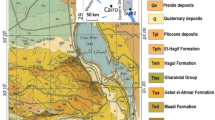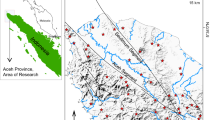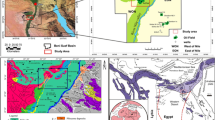Abstract
Geophysical techniques such as gravity, magnetic and seismology are perfect tools for detecting subsurface structures of local, regional as well as of global scales. The study of the earthquake records can be used for differentiating the active and non-active fault elements. In the current study, more than 2,200 land magnetic stations have been measured using two proton magnetometers. The data are corrected for diurnal variations and then reduced by the International Geomagnetic Reference Field. The corrected data have been interpreted by different techniques after filtering the data to separate shallow sources (basaltic sheet) from the deep sources (basement complex). Both Euler deconvolution and 3-D magnetic modeling were carried out. The results of interpretation indicate that the depth to the upper surface of basaltic sheet ranges from <10 to 600 m, depth to the lower surface ranges from 60 to 750 m, while the thickness of the basaltic sheet varies from <10 to 450 m. Moreover, gravity measurements are conducted at 2,250 stations using a CG-3 gravimeter. The measured values are corrected to construct a Bouger anomaly map. The least squares technique is then applied for regional–residual separation. The third order of least squares is found to be the most suitable to separate the residual anomalies from the regional one. The resultant third-order residual gravity map is used to delineate the structural fault systems of different characteristic trends. The trends show an NW–SE trend parallel to that of Gulf of Suez, an NE–SW trend parallel to the Gulf of Aqaba and an E–W trend parallel to that of the Mediterranean Sea. Taking seismological records into consideration, it is found that most of the 24 earthquake events recorded in the study area are located on fault elements. This gives an indication that the delineated fault elements are active.










Similar content being viewed by others
References
Abou Elenean KM, Mohamed ME, Hussein HM (2009) Source parameters and ground motion of the Suez–Cairo shear zone earthquakes, Eastern Desert, Egypt. Nat Hazards. doi:10.1007/s11069-009-9388-x
Abu El-Enein KA (1997) Study on the seismotectonics of Egypt in relation to the Mediterranean and Red Sea tectonics. PhD thesis, Ain Shams University, Cairo, Egypt
Araffa SAS (2010) Geophysical investigation for shallow subsurface geotechnical problems of Mokattam area, Cairo, Egypt. Environ Earth Sci J 59:1195–2207
Baranov V (1957) A new method for interpretation of aeromagnetic maps: pseudo-gravimetric anomalies. Geophysics 22:359–383
Baranov V (1975) Potential fields and their transformation in applied geophysics. Geoexploration monographs, series 1–6, Gebrüder, Borntraeger, Berlin-Stuttgart
Baranov V, Naudy H (1964) Numerical calculation of the formula of reduction to the magnetic pole. Geophysics 29:67–79
Bhattacharyya BK (1965) Two dimensional harmonic analysis as a tool for magnetic interpretation. Geophysics 30(5):829–857
Bhattacharyya BK (1967) Some general properties of potential field in space and frequency domains; a review. Geoexploration 5:127–143
Davis JC (1973) Statistics and data analysis in geology. John Wiley & Sons, Inc, New York. ISBN 10: 0471198951 / 13: 9780471198956
Geological Survey of Egypt (EGSMA) (1998) Geology of Inshas Area. Geol Surv of Egypt, internal report
Geosoft Program (Oasis Montaj) (2007) Geosoft mapping and application system. Inc, Suit 500, Richmond St., West Toronto, ON Canada N5SIV6
Issawy EA, Radwan AH, Ddhy SA, Rayan A (2010) Monitoring of recent crustal movements around Cairo by repeated gravity and geodetic observations. Contributions Geophys Geodesy J 40(2):173–184
Kebeasy RM (1990) Seismicity. In Geology of Egypt. Baklema, Rotterdam, pp 51–59
Maamoun M, Ibrahim E (1978) Tectonic activity in Egypt as indicated by earthquakes. Helwan Inst Astronom Geophys Bull 170
Moharram AM, Elghazouli AY, Bommer JJ (2008) A framework for a seismic risk model for Greater Cairo. Soil Dynamics Earthq Eng 28:795–811
Monteiro Santos FA, Sultan SA (2008) On the 3-D inversion of vertical electrical soundings: application to the South Ismailia Cairo Desert Road area, Cairo, Egypt. J Appl Geophys 65:97–110
Reilinger RE, McClusky SC, Oral MB, King RW, Toksoz MN (1997) Global Positioning System measurements of present-day crustal movements in the Arabia–Africa–Eurasia plate collision zone. J Geophys Res 102(B5):9983–9999
Reynolds JM (1997) An introduction to applied and environmental geophysics. Wiley, Chichester, 796 pp
Sultan SA, Monteiro Santos FA (2008) 1-D and 3-D resistivity inversions for geotechnical investigation. J Geophys Eng 5:1–11
Sultan SA, Santos FAM (2008) Evaluate subsurface structures and stratigraphic units using 2-D electrical and magnetic data at the area north Greater Cairo, Egypt. Int J Appl Earth Observ Geoinf 10:56–67
Sultan SA, Monteiro Santos FA, Abbas M (2010) Joint inversion interpretation for gravity and resistivity data: case study: at New Helioplis City, Cairo, Egypt. Near Surf Geophys J 8:43–53
Thompson DTT (1982) Euler, a new technique for making computer assisted depth estimates from magnetic data. Geophysics 47:31–37
Author information
Authors and Affiliations
Corresponding author
Rights and permissions
About this article
Cite this article
Araffa, S.A.S., Monteiro Santos, F.A. & Arafa-Hamed, T. Assessment of subsurface structural elements around greater Cairo by using integrated geophysical tools. Environ Earth Sci 71, 3293–3305 (2014). https://doi.org/10.1007/s12665-013-2716-1
Received:
Accepted:
Published:
Issue Date:
DOI: https://doi.org/10.1007/s12665-013-2716-1




